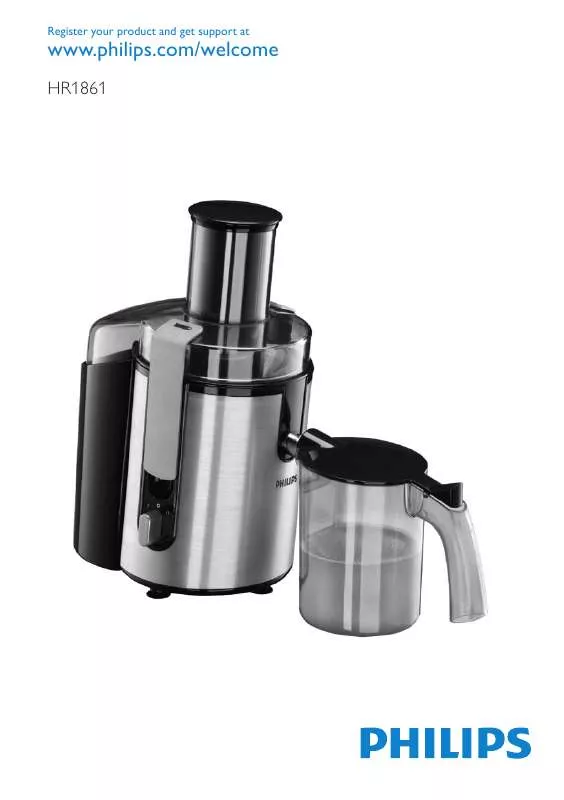사용자 설명서 PHILIPS HR-1861
Lastmanuals는 사용자 가이드, 오너매뉴얼, 퀵스타트 가이드, 기술 데이터 시트 등의 하드웨어와 소프트웨어의 사용과 관련된 사용자 설명서를 공유, 저장, 그리고 검색하는 서비스를 제공한다. 잊지마세요 : 물건을 사기 전에 반드시 사용자 설명서를 읽으세요
만일 이 문서가 고객님이 찾는 사용설명서, 지도서, 안내서라면, 다운로드 받으세요. Lastmanuals는 고객님께 PHILIPS HR-1861 사용설명서를 빠르고 손쉽게 찾아드립니다. PHILIPS HR-1861 사용설명서가 고객님에게 도움이 되기를 바랍니다.
Lastmanuals은 PHILIPS HR-1861사용자설명서를 다운로드는 것을 도와드립니다.


수동 요약 : 사용설명서 PHILIPS HR-1861
사용을 위한 자세한 설명은 사용자 가이드에 있습니다.
[. . . ] Never let the appliance operate unattended. If you detect cracks in the filter or if the filter is damaged in any way, do not use the appliance anymore and contact the nearest Philips service centre. Never reach into the feeding tube with your fingers or an object while the appliance is running. Do not touch the small cutting blades in the base of the filter. [. . . ] - Speed 2 is suitable for all kinds of fruits and vegetables.
8
EnglisH
4 Put the pre-cut pieces in the feeding tube and gently press them down towards the rotating filter with the pusher (Fig. Do not exert too much pressure on the pusher, as this could affect the quality of the end result and it could even cause the filter to come to a halt. Never insert your fingers or an object into the feeding tube. After you have processed all ingredients and the juice flow has stopped, switch off the appliance and wait until the filter has stopped rotating. 5 Slide the foam separator into the juice jug (1) and place the lid on the juice jug (2). In this way, the foam stays behind in the jug when you pour out the juice. 10) Note: If you want your drink to have a foamy layer, do not use the foam separator. Tips Use fresh fruit and vegetables, as they contain more juice. Pineapples, beetroots, celery stalks, apples, cucumbers, carrots, spinach, melons, tomatoes, pomegranates, oranges and grapes are particularly suitable for processing in the juice extractor. You do not have to remove thin peels or skins. those of oranges, pineapples and uncooked beetroots need to be removed. Also remove the white pith of citrus fruits because it has a bitter taste. When preparing apple juice, remember that the thickness of the apple juice depends on the kind of apple you are using. The juicier the apple, the thinner the juice. Choose a kind of apple that produces the type of juice you prefer. To slow down this process, add a few drops of lemon juice. Fruits that contain starch, such as bananas, papayas, avocados, figs and mangoes are not suitable for processing in the juice extractor. Use a food processor, blender or bar blender to process these fruits. lettuce can also be processed in the juice extractor. Drink the juice immediately after you have extracted it. If it is exposed to air for some time, the juice will lose its taste and nutritional value. To extract the maximum amount of juice, always press the pusher down slowly. [. . . ] 8 Add lemon juice and salt to taste.
EnglisH 11
Fruit and vegetables facts Fruit/vegetable Apples Apricots Beetroot Blueberries Brussels sprouts Cabbage Carrots Celery Cucumber Fennel Grapes Kiwi fruit Melons Nectarines Peaches Pears Pineapples Raspberries Tomatoes Vitamins/minerals Vitamin C High in dietary fibre, contains potassium Good source of folate, dietary fibre, vitamin C and potassium Vitamin C Vitamin C, B, B6, E, folate and dietary fibre Vitamin C, folate, potassium, B6 and dietary fibre Vitamin A, C, B6 and dietary fibre Vitamin C and potassium Vitamin C Vitamin C and dietary fibre Vitamin C, B6 and potassium Vitamin C and potassium Vitamin C, folate, dietary fibre and vitamin A Vitamin C, B3, potassium and dietary fibre Vitamin C, B3, potassium and dietary fibre Dietary fibre Vitamin C Vitamin C, iron, potassium and magnesium Vitamin C, dietary fibre, vitamin E, folate and vitamin A Kilojoule/calorie count 200g=150kJ (72 cals) 30g=85kJ (20 cals) 160g=190kJ (45 cals) 125g=295kJ (70 cals) 100g=110kJ (26 cals) 100g=110kJ (26 cals) 120g=125kJ (30 cals) 80g=55kJ (7 cals) 280g=120kJ (29 cals) 300g=145kJ (35 cals) 125g=355kJ (85 cals) 100g=100kJ (40 cals) 200=210kJ (50 cals) 180g=355kJ (85 cals) 150g=205kJ (49 cals) 150g=250kJ (60 cals) 150g=245kJ (59 cals) 125g=130kJ (31 cals) 100g=90kJ (22 cals) Juicing speed high low high low low high high high low low low low low high high high high low low
12
EnglisH
Troubleshooting
This chapter summarises the most common problems you could encounter with your juice extractor. Please read the different sections for more details. , (www. philips. co. kr) . *(): (02)709-1200 * : (080)600-6600() 2 1/2 12 1 1 1 1 2 1 . [. . . ]
PHILIPS HR-1861 사용자 가이드를 다운로드 받기 위한 면책조항
Lastmanuals는 사용자 가이드, 오너매뉴얼, 퀵스타트 가이드, 기술 데이터 시트 등의 하드웨어와 소프트웨어의 사용과 관련된 사용자 설명서를 공유, 저장, 그리고 검색하는 서비스를 제공한다.
사용자가 원하는 자료가 존재하지 않거나, 불완전하거나, 다른 언어로 되어 있거나, 모델이나 언어가 설명과 맞지 않는 경우 등의 어떠한 경우에도 Lastmanuals는 책임이 없다. 예로, Lastmanuals는 번역 서비스를 제공하지 않는다.
이 계약서의 조항에 동의하시면 계약서 끝에 있는 "사용자 설명서 다운로드받기"를 클릭하세요. PHILIPS HR-1861 사용자 설명서의 다운로드가 시작될 것입니다.
